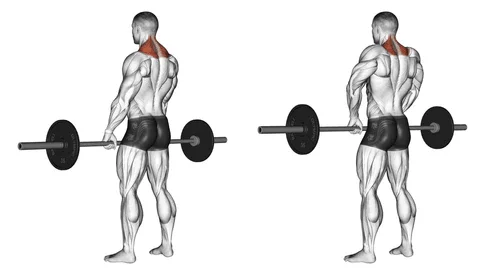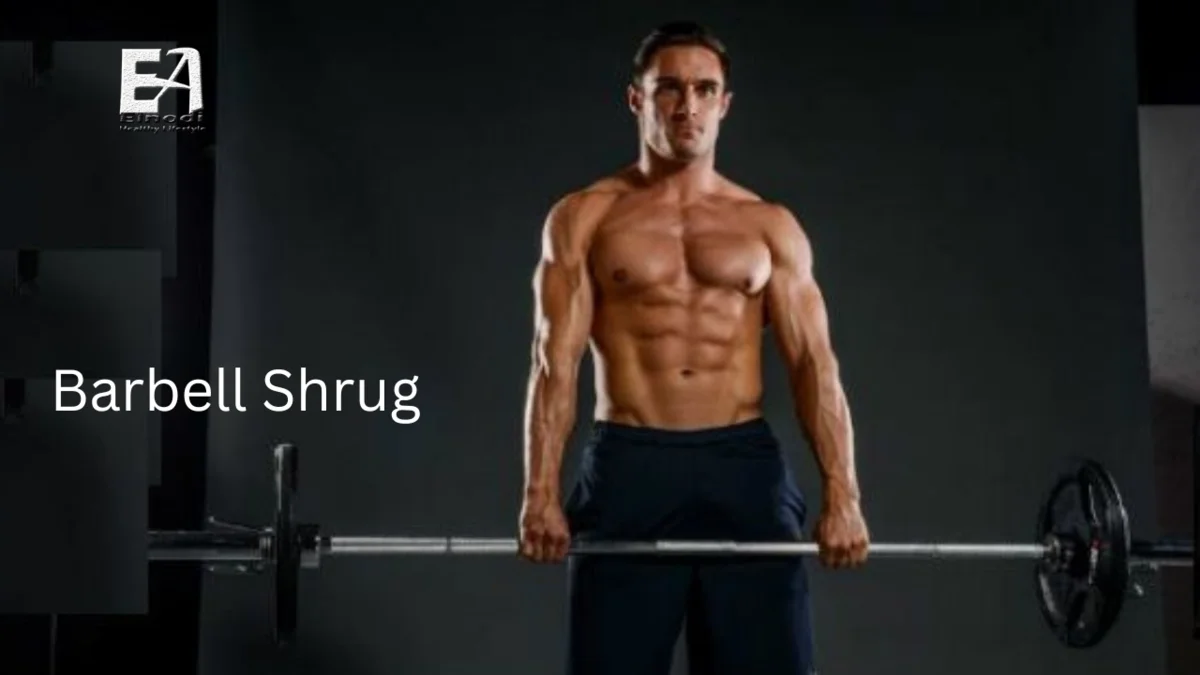The barbell shrug is a simple yet effective exercise that can help you build bigger, stronger traps. It is a compound exercise, which means that it works for multiple muscle groups at the same time. In this case, the primary muscle group worked is the trapezius, which is located at the back of your neck and shoulders. (1)
Benefits of barbell shrug
Improved Upper Back Strength
Any serious lifter understands the importance of having a strong upper back for deadlifting and for creating a sturdy shelf for the bar in back squats. A stronger upper back enables you to keep your spine neutral during deadlifts. It makes a more stable basis from which to press for the bench press. You should better rest a barbell on your traps for support during the squat.
Improved Olympic Lifting Ability
In both the clean and jerk and the snatch, an explosive shrug ensures a vertical bar path and allows the lifter to attain full extension. As a result, explicitly training the shrug can assist enhance overall performance in the Olympic lifts. (2)
Stronger, More Stable Neck Muscles
Contact sports such as American football, rugby, hockey, and combat sports necessitate an elite degree of neck strength to avoid injury. For contact sport athletes who require a strong and stable neck, shrugs can be employed as part of a comprehensive neck strengthening program.
Isolation Of The Traps
Because it is a solitary exercise, the barbell shrug is one of the best trapezius strengthening exercises. This indicates that it only works on one muscle group. Compound exercises can engage the traps, but not as much as isolated exercises such as the barbell shrug.
Improved Physique
Shrugs are a great method to help your traps flourish. Big, strong traps contribute to the appearance of a muscular frame, which many lifters covet.
Muscles Worked By The Barbell Shrug

Primary Muscle Groups:
The trapezius and rhomboids are typically worked by the barbell shrug. These upper back muscles work together to support and pull back your shoulders.
Secondary Muscle Groups:
The barbell shrug activates both the core abdominal muscles and the forearms secondarily. While lifting the weight, your core muscles contract to help stabilize your upper body.
Furthermore, the barbell shrug strengthens your forearms by engaging your brachioradialis to secure the barbell.
How to do The Barbell Shrug

Instructions for barbell shrug
- In a rack, place the safeties just below waist height.
- Assume a standing position, holding the bar in front of you.
- Hinge forward, inhale, and double overhand hold the bar.
- Stand tall to maintain a neutral spine.
- To raise the shoulders, contract the traps. Squeeze the bar hard at the top and slowly drop it back to the starting position.
- Repeat until the desired number of repetitions has been reached.
Barbell Shrug Tips
- Looking slightly up while shrugging may help to improve the contraction since traps aid to restrict head movement. A ballistic movement could result in a neck injury, thus this action should be smooth and controlled.
- High reps and explosive movements (e.g., snatch grip high pulls) tend to stimulate the traps, so plan your accessory training accordingly.
- Limit the weight’s momentum and jerking or bouncing. Nobody cares how much you shrug.
- Allowing the head to lean forward excessively while you squeeze the traps can put the neck in jeopardy and result in damage.
- Including a pause at the top of the action can aid in improving the mind-muscle connection.
Reps, Sets, And Frequency For Barbell Shrug
- For muscle hypertrophy (muscle growth): Aim for an 8-12 rep range every set.
- For strength and power: Reduce the rep range to 4-6 repetitions per set.
- For Endurance: Do 15-20 reps per set. (3)
For Beginners
- Reps: Begin with 8-10 reps per set.
- Sets: Complete 2-3 sets of the exercise.
- Frequency: Include the exercise 1-2 times per week in your shoulder workout routine.
For Intermediate
- Reps: Aim 10-15 repetitions per set.
- Sets: Aim for 3-4 sets of the exercise.
- Frequency: 2-3 times per week.
Advanced:
- Reps: Increase the challenge by performing 12-20 repetitions per set.
- Sets: Perform 4-5 sets of the exercise.
- Frequency: 2-3 times per week.
Who Should Do the Shrug
Strength and Power Athletes
Strong upper traps aid in squatting, deadlifting, and pressing. At least some of the time, directly targeting the traps with shrugs can assist strength athletes reach their full potential in their main lifts.
Bodybuilders and Physique Athletes
The shrug is an effective exercise for developing the upper traps. The shrug is necessary if you want to hypertrophy your upper traps. Those who have been training for a year or fewer should expect their traps to increase from exercises like deadlifts and carries and may not need to spend time on the shrug. The shrug is an easy choice for intermediate and expert lifters aiming to take their body to the next level.
General Fitness
The shrug is no longer popular among personal trainers. There are fears that the shrug will exacerbate the problem of most people being upper-trap dominant due to poor posture habits. Shrugs can actually aid improve posture, despite the fact that posture is vital and upper trap dominance is typical. The eccentric or lowering component of the action gives the upper trap a much-needed stretch. When done as part of a well-designed strength training plan, this can have a therapeutic effect.
Common mistakes
- Using too much weight. This is the most common blunder. When you use too much weight, you are more likely to rely on momentum to raise the barbell, which might result in injury.
- Not keeping your back straight. This can cause pain in your lower back. Throughout the activity, make sure to keep your back straight and your core engaged.
- Swinging the barbell. The barbell should be moved in a controlled, steady motion. Do not raise the barbell.
- Shrugging your shoulders too high. When your shoulders are level with your ears, come to a halt. Shrugging your shoulders too far back can strain your neck.
- Bending your elbows. This might divert attention away from your traps and place strain on your biceps. Throughout the exercise, keep your elbows straight.
- Not engaging your core. To assist stabilize your spine, keep your core engaged throughout the exercise.
Shrug Variations
Kettlebell or Dumbbell Shrug

The main advantage of kettlebell or dumbbell shrugs is that they allow the lifter to work with their hands at their sides rather than in front of them as with a barbell. Training the traps from various angles can assist increase strength and hypertrophy, and for some lifters, it may be a more shoulder-friendly choice.
You will also utilize less weight, making these a more joint-friendly solution in the long term. To assist stabilize your spine, keep your core engaged throughout the exercise.
Wide-Grip Shrug
Shrugs can be performed with either a narrow or a wide grip. This is a good technique for strengthening the muscles used in the shrug at various angles. Different positions might be used to increase transfer to specific activities. A wide-grip or snatch-grip shrug, for example, will have a larger degree of transfer if you are employing it to improve your pull in the snatch.
It may also assist athletes in determining the best position to work on shrugs. The optimum position for you is determined by your own anatomy. If a wider grip allows you to obtain a better mind-muscle connection or a good pump, it is a good indication that the wider grip version is preferable for you.
Power Shrug
The power shrug is a variation on the clean and jerk or snatches that requires first building force with the lower body while starting in a power position and then explosively shrugging the bar.
This variation solely uses the shrug, not a pull like the clean or snatch pull. This exercise can aid in the development of the talent of transferring force from the lower to the upper body, with a focus on developing power in the traps. This variation can aid in the improvement of Olympic lifting technique and performance.
Alternatives
Deadlifts
The traps help maintain the shoulder girdle while the arms are bearing a heavy barbell, as they do in the deadlift, in addition to raising or shrugging the shoulder. For many lifters, especially beginners, deadlifts give plenty of stimulus to the upper traps.
Instead of going really heavy with shrugs, deadlifts are an excellent choice for activating the traps with large amounts of force while training in a reduced rep range. Many powerlifters have well-developed traps, but they do not shrug. This demonstrates the deadlift’s effectiveness in developing traps.
Farmer’s Carry
The Farmer’s carry and other heavy carry variations train the traps in the same way as the deadlift does. The traps help to stabilize the shoulder girdle against the downward pull of hand weight. The farmer’s carry also improves total body strength, dynamic hip stability, grip strength, and overall fitness. If you want to work on your traps while also checking off a few other crucial training boxes, the farmer’s carry is a wonderful option.
Rows
The upright row requires shoulder elevation and strong upper trap engagement. The mid trap is developed through seated and bent-over row variants. Although the upright row is debatable, it can be performed in adults with otherwise healthy shoulders, and changes can be made to make it safe.
Summary
The barbell shrug demonstrates that wonderful things may be found in little packages. Although the shrug is a simple movement, it has significant implications for the entire development of our upper bodies.
If you’re looking to turbocharge your trap gains, implement barbell shoulder shrugs into your workouts, and you’ll have a stronger, bigger, and more resilient upper body.
FAQs
what is the difference between a barbell shrug and a trap bar shrug?
are barbell shrugs worth doing?
what is the difference between a shrug and a power shrug?
What machine is best for shrugs?
References
1. DeWeese, B. H., & Scruggs, S. K. (2012). The countermovement shrug. Strength & Conditioning Journal, 34(5), 20-23.
2. Suchomel, T. J., Beckham, G. K., & Wright, G. A. (2013). Lower body kinetics during the jump shrug: Impact of load. Journal of Terminology, 2(2), 19-22.
3. Džaja, D., Čibarić, M., Šeketa, G., & Magjarević, R. (2023). Accelerometer-based algorithm for the segmentation and classification of repetitive human movements during workouts. Automatika, 64(2), 211-224.





